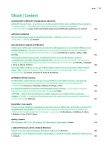Faster Insulin Aspart – a new prandial insulin analogue
Authors:
MUDr. Milan Flekač, Ph.D.
Authors‘ workplace:
III. interní klinika endokrinologie a metabolizmu 1. LF UK a VFN v Praze
Published in:
Vnitř Lék 2017; 63(10): 697-702
Category:
Reviews
Overview
Preventing postprandial blood glucose excursions is one of the most challenging aspects of achieving adequate control, especially in patients with better long-term compensation of diabetes. Contemporary prandial insulin analogues that have more favorable properties than human insulin in terms of accelerated absorption, earlier onset of action and shorter duration of action are still significantly slower than endogenous insulin in healthy individuals. Fast-acting insulin aspart (FIAsp – faster aspart) is insulin aspart enriched with two excipients, of which niacinamide is responsible for accelerating absorption after subcutaneous administration. The responsible mechanism is to accelerate the formation of monomers and to accelerate the transfer through capillary endothelial cells into the bloodstream. The article summarizes the most important outcomes of preclinical and clinical evaluation of new insulin and its relevance to practice.
Key words:
faster apart – FIAsp – Onset trial – pharmacodynamics – pharmacokinetics – postprandial glycaemia
Sources
1. American Diabetes Association. Standards of Medical Care in Diabetes – 2016. Diabetes Care 2016; 39(Suppl 1): S1-S119. Dostupné z WWW: <http://care.diabetesjournals.org/content/suppl/2015/12/21/39.Supplement_1.DC2/2016-Standards-of-Care.pdf>.
2. Ryden L, Grant PJ, Anker SD et al. ESC Guidelines on diabetes, pre-diabetes, and cardiovascular diseases developed in collaboration with the EASD: the Task Force on diabetes, pre-diabetes, and cardiovascular diseases of the European Society of Cardiology (ESC) and developer in collaboration with the European Association for the Study of Diabetes (EASD). Eur Heart J 2013; 34(39): 3035–3087. Dostupné z DOI: <http://dx.doi.org/10.1093/eurheartj/eht108>. Erratum in Eur Heart J 2014 Jul; 35(27): 1824.
3. [International Diabetes Federation Guideline Development Group]. Guidelines for management of postmeal glucose in diabetes. Diabetes Res Clin Pract 2014; 103(2): 256–268. Dostupné z DOI: <http://dx.doi.org/10.1016/j.diabres.2012.08.002>.
4. Nathan DM. Long-term complications of diabetes mellitus. N Engl J Med 1993; 328(23): 1676–1685.
5. Nathan DM, Cleary PA, Backlund JY et al.[Diabetes Control and Complications Trial/Epidemiology of Diabetes Interventions and Complications (DCCT/EDIC) Study Research Group]. Intensive diabetes treatment and cardiovascular disease in patients with type 1 diabetes. N Engl J Med 2005; 353(25): 2643–2653.
6. Nathan DM. [DCCT/EDIC Research Group]. Diabetes Control and Complications Trial/ Epidemiology of Diabetes Interventions and Complications Study at 30 years: overview. Diabetes Care 2014; 37(1): 9–16. Dostupné z DOI: <http://dx.doi.org/10.2337/dc13–2112>.
7. Woerle HJ, Neumann C, Zschau S et al. Impact of fasting and postprandial glycemia on overall glycemic control in type 2 diabetes Importance of postprandial glycemia to achieve target HbA1c levels. Diabetes Res Clin Pract 2007; 77(2): 280–285.
8. Monnier L, Lapinski H, Colette C. Contributions of fasting and postprandial plasma glucose increments to the overall diurnal hyperglycemia of type 2 diabetic patients. Variations with increasing levels of HbA1c. Diabetes Care 2003; 26(3): 881–885.
9. Mitrakou A, Kelley D, Mokan M Role of reduced suppression of glucose production and diminished early insulin release in impaired glucose tolerance. N Engl J Med 1992; 326(1): 22–29.
10. Heise T. Getting closer to physiologic insulin secretion. Clin Ther 2007;29(Suppl D): S161-S165. Dostupné z DOI: <http://dx.doi.org/10.1016/j.clinthera.2007.12.012>.
11. Heinemann L, Muchmore DB. Ultrafast-acting insulins: state of the art. J Diabetes Sci Technol 2012; 6(4): 728–742.
12. Home PD. The pharmacokinetics and pharmacodynamics of rapid-acting insulin analogues and their clinical consequences. Diabetes Obes Metab 2012; 14(9): 780–788. Dostupné z DOI: <http://dx.doi.org/10.1111/j.1463–1326.2012.01580.x>.
13. Hermansen K, Bohl M, Schioldan AG. Insulin aspart in the management of diabetes mellitus: 15 years of clinical experience. Drugs 2016; 76(1): 41–74. Dostupné z DOI: <http://dx.doi.org/10.1007/s40265–015–0500–0>.
14. Buckley et al. Greater permeation rate of insulin aspart formulated with niacinamide. Diabetes 2015; 64(Suppl 1): Abstract 1024-P.
15. Heise T, Pieber TR, Danne T et al. A Pooled Analysis of Clinical Pharmacology Trials Investigating the Pharmacokinetic and Pharmacodynamic Characteristics of Fast-Acting Insulin Aspart in Adults with Type 1 Diabetes. Clin Pharmacokinet 2017; 56(5): 551–559. Dostupné z DOI: <http://dx.doi.org/10.1007/s40262–017–0514–8>.
16. Hövelmann U, Heise T, Nosek L et al. Pharmacokinetic Properties of Fast-Acting Insulin Aspart Administered in Different Subcutaneous Injection Regions. Clin Drug Investig 2017; 37(5): 503–509. Dostupné z DOI: <http://dx.doi.org/10.1007/s40261–017–0499-y>.
17. Bantle JP, Neal L, Frankamp LM. Effects of the anatomical region used for insulin injections on glycemia in type I diabetes subjects. Diabetes Care 1993; 16(12): 1592–1597.
18. ter Braak EW, Woodworth JR, Bianchi R et al. Injection site effects on the pharmacokinetics and glucodynamics of insulin lispro and regular insulin. Diabetes Care 1996; 19(12): 1437–1440.
19. Mudaliar SR, Lindberg FA, Joyce M et al. Insulin aspart (B28 asp-insulin): a fast-acting analog of human insulin: absorption kinetics and action profile compared with regular human insulin in healthy nondiabetic subjects. Diabetes Care 1999; 22(9): 1501–1506.
20. Apidra (insulin glulisine). EPAR – Assessment Report – Apidra-H-C-557-X-0023. 2010. Dostupné z WWW:
21. Vora JP, Burch A, Peters JR et al. Relationship between absorption of radiolabeled soluble insulin, subcutaneous blood flow, and anthropometry. Diabetes Care 1992; 15(11): 1484.
22. Russell-Jones D, Bode BW, De Block C et al. Fast-Acting Insulin Aspart Improves Glycemic Control in Basal-Bolus Treatment for Type 1 Diabetes: Results of a 26-Week Multicenter, Active-Controlled, Treat-to-Target, Randomized, Parallel-Group Trial (onset 1). Diabetes Care 2017; 40(7): 943–950. Dostupné z DOI: <http://dx.doi.org/10.2337/dc16–1771>.
23. Bowering K, Case C, Harvey J et al. Faster Aspart Versus Insulin Aspart as Part of a Basal-Bolus Regimen in Inadequately Controlled Type 2 Diabetes: The onset 2 Trial. Diabetes Care 2017; 40(7): 951–957. <http://dx.doi.org/10.2337/dc16–1770>.
24. Heise T, Haahr H, Jensen L et al. Faster-acting insulin aspart improves postprandial glycemia vs insulin aspart in patients with type 1 diabetes mellitus (T1DM). Diabetes 2014; 63(Suppl 1): A34.
Labels
Diabetology Endocrinology Internal medicineArticle was published in
Internal Medicine

2017 Issue 10
Most read in this issue
- COSYREL – an efficient fixed combination for treatment of hypertension, stable ISHD and heart failure
- Surgical treatment of aortic root aneurysm: comparison of Bentall procedure and David reimplantation of aortic valve
- Physical activity – the Holy Grail of modern medicine?
- Endocrine orbitopathy: the present view of a clinical endocrinologist
